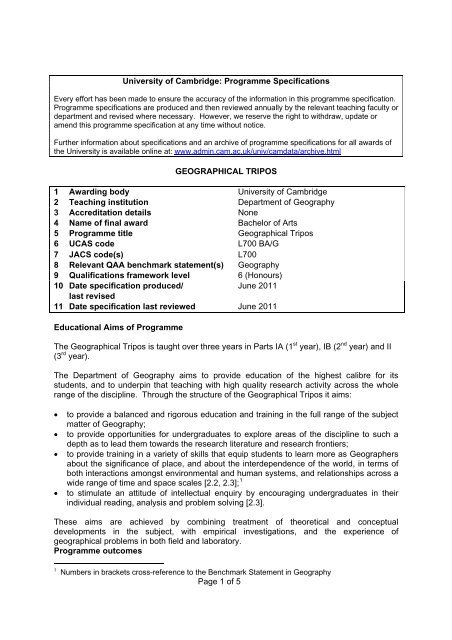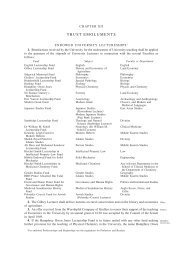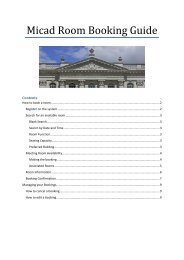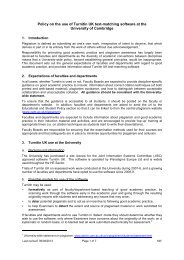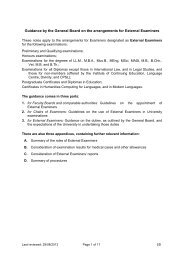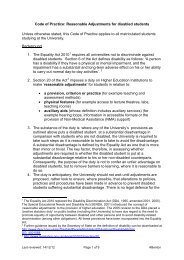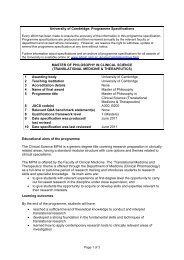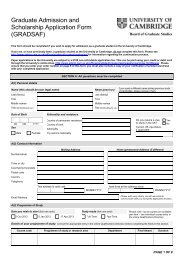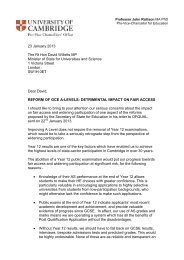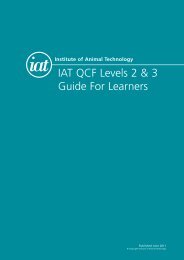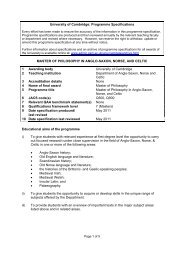Geographical Tripos - University of Cambridge
Geographical Tripos - University of Cambridge
Geographical Tripos - University of Cambridge
Create successful ePaper yourself
Turn your PDF publications into a flip-book with our unique Google optimized e-Paper software.
<strong>University</strong> <strong>of</strong> <strong>Cambridge</strong>: Programme Specifications<br />
Every effort has been made to ensure the accuracy <strong>of</strong> the information in this programme specification.<br />
Programme specifications are produced and then reviewed annually by the relevant teaching faculty or<br />
department and revised where necessary. However, we reserve the right to withdraw, update or<br />
amend this programme specification at any time without notice.<br />
Further information about specifications and an archive <strong>of</strong> programme specifications for all awards <strong>of</strong><br />
the <strong>University</strong> is available online at: www.admin.cam.ac.uk/univ/camdata/archive.html<br />
GEOGRAPHICAL TRIPOS<br />
1 Awarding body <strong>University</strong> <strong>of</strong> <strong>Cambridge</strong><br />
2 Teaching institution Department <strong>of</strong> Geography<br />
3 Accreditation details None<br />
4 Name <strong>of</strong> final award Bachelor <strong>of</strong> Arts<br />
5 Programme title <strong>Geographical</strong> <strong>Tripos</strong><br />
6 UCAS code L700 BA/G<br />
7 JACS code(s) L700<br />
8 Relevant QAA benchmark statement(s) Geography<br />
9 Qualifications framework level 6 (Honours)<br />
10 Date specification produced/<br />
June 2011<br />
last revised<br />
11 Date specification last reviewed June 2011<br />
Educational Aims <strong>of</strong> Programme<br />
The <strong>Geographical</strong> <strong>Tripos</strong> is taught over three years in Parts IA (1 st year), IB (2 nd year) and II<br />
(3 rd year).<br />
The Department <strong>of</strong> Geography aims to provide education <strong>of</strong> the highest calibre for its<br />
students, and to underpin that teaching with high quality research activity across the whole<br />
range <strong>of</strong> the discipline. Through the structure <strong>of</strong> the <strong>Geographical</strong> <strong>Tripos</strong> it aims:<br />
• to provide a balanced and rigorous education and training in the full range <strong>of</strong> the subject<br />
matter <strong>of</strong> Geography;<br />
• to provide opportunities for undergraduates to explore areas <strong>of</strong> the discipline to such a<br />
depth as to lead them towards the research literature and research frontiers;<br />
• to provide training in a variety <strong>of</strong> skills that equip students to learn more as Geographers<br />
about the significance <strong>of</strong> place, and about the interdependence <strong>of</strong> the world, in terms <strong>of</strong><br />
both interactions amongst environmental and human systems, and relationships across a<br />
wide range <strong>of</strong> time and space scales [2.2, 2.3]; 1<br />
• to stimulate an attitude <strong>of</strong> intellectual enquiry by encouraging undergraduates in their<br />
individual reading, analysis and problem solving [2.3].<br />
These aims are achieved by combining treatment <strong>of</strong> theoretical and conceptual<br />
developments in the subject, with empirical investigations, and the experience <strong>of</strong><br />
geographical problems in both field and laboratory.<br />
Programme outcomes<br />
1 Numbers in brackets cross-reference to the Benchmark Statement in Geography<br />
Page 1 <strong>of</strong> 5
Knowledge and Understanding<br />
The <strong>Geographical</strong> <strong>Tripos</strong> is designed to ensure that, at the end <strong>of</strong> their course, students will<br />
have acquired knowledge and developed understanding <strong>of</strong> the following:<br />
• The reciprocal relationships between physical and human aspects <strong>of</strong> environment<br />
and landscapes [3.2]. This is provided in particular through courses in environmental<br />
and cultural geography. The first-year course, for example, aims explicitly to introduce<br />
students to ideas regarding the changing relationship <strong>of</strong> people to their environment via<br />
the concept <strong>of</strong> ‘resources’, approached from ecological, economic and political<br />
perspectives. Students also develop an understanding <strong>of</strong> socially constructed ways <strong>of</strong><br />
representing and interpreting the world, for example through papers comprising lectures<br />
and teaching material on Cultural Geography and the Social Engagement with Nature.<br />
• The concept <strong>of</strong> spatial variation [3.3]. Through physical geography courses across the<br />
<strong>Tripos</strong> students are taught about the pattern and dynamic nature <strong>of</strong> spatial variation in the<br />
physical world; for example, courses in Earth Observation, and Biogeography cover the<br />
acquisition, processing, integration, validation and interpretation <strong>of</strong> diverse kinds <strong>of</strong><br />
spatial data. Human geography courses, both individually and across the sub-discipline,<br />
enable the appreciation <strong>of</strong> spatial variation across economic, social and political activity at<br />
a variety <strong>of</strong> scales. Explanations for spatial variation are a key consideration <strong>of</strong> residential<br />
fieldclasses.<br />
• The constitution <strong>of</strong> place and an appreciation <strong>of</strong> inequality between people and<br />
places, [3.4, 3.8] and the way in which places are continually evolving. These themes<br />
are taught across papers in human geography, in courses which discuss, for example,<br />
poverty and social exclusion in Britain, the causes and consequences <strong>of</strong> urban<br />
transformations in different contexts and theories <strong>of</strong> development in non-western<br />
societies.<br />
• The patterns, processes, interactions and change within the world system [3.5]<br />
The first-year course in physical geography provides an introduction to the components <strong>of</strong><br />
the Earth System, which are explored in greater depth in later stages <strong>of</strong> the course, for<br />
example, through papers comprising lectures and teaching material on glacial systems,<br />
atmospheric processes, coastal dynamics , biogeography or quaternary environments.<br />
Natural impacts on human activity are studied specifically through a paper on<br />
environmental hazard and risk, and indirectly in other papers within the <strong>Tripos</strong>.<br />
• The significance <strong>of</strong> spatial and temporal scale and an appreciation <strong>of</strong> change [3.6,<br />
3.7] These are integral components across most <strong>of</strong> the courses <strong>of</strong>fered. For example the<br />
first-year human geography course focuses on the geographical extent <strong>of</strong>, and<br />
explanations for, the increasing globalization <strong>of</strong> the contemporary world and the multiple<br />
restructurings involved at a range <strong>of</strong> spatial scales. At the same time, notions <strong>of</strong><br />
temporal scale are explored in lectures and teaching material on historical geography,<br />
and through a range <strong>of</strong> papers in environmental and physical geography, which examine<br />
the processes influential in moulding the landscape through time.<br />
• The nature <strong>of</strong> the discipline. [3.9] The dynamic, plural and contested nature <strong>of</strong><br />
Geography, its development as an academic subject and its relationships with other<br />
subjects within the natural and social sciences are concepts introduced to first year<br />
students within the two compulsory papers. For second year students there is a<br />
compulsory and examined paper on <strong>Geographical</strong> Ideas which extends their<br />
understanding <strong>of</strong> these issues.<br />
• The application <strong>of</strong> geography [3.10-3.13]. Both in lecture courses and particularly<br />
through the practical courses which form an important component <strong>of</strong> the first two years,<br />
Page 2 <strong>of</strong> 5
Skills<br />
students have the opportunity to develop knowledge <strong>of</strong> field, laboratory, archival,<br />
cartographic, statistical, computing, modelling, remote sensing and GIS techniques.<br />
They learn the appropriate application <strong>of</strong> these techniques in addressing specific<br />
geographical questions, and obtain direct experience <strong>of</strong> both quantitative and qualitative<br />
methodologies.<br />
The <strong>Geographical</strong> <strong>Tripos</strong> aims to enable undergraduates to develop both analytical skills<br />
which allow particular problems to be dissected into their constituent parts (in order that<br />
particular linkages and relationships can be understood), and synthesising skills which allow<br />
a more holistic grasp <strong>of</strong> the nature <strong>of</strong> problems and locations to be achieved. More<br />
specifically, on completing the programme we want students to have developed a wide range<br />
<strong>of</strong> skills [4.4], grouped as follows:<br />
Intellectual skills:<br />
Practical skills:<br />
Transferable skills:<br />
Interpretative skills - the ability to read, analyse, deconstruct and<br />
understand texts <strong>of</strong> all kinds - from the written word, to the physical and<br />
human landscape and representations there<strong>of</strong>.<br />
Literacy - the presentation <strong>of</strong> ideas and arguments and the synthesis<br />
<strong>of</strong> information from disparate sources, in a narrative form which is<br />
logical, structured and coherent.<br />
Research skills - the collection, recording, processing, interpreting<br />
and presenting <strong>of</strong> data, together with bibliographic skills.<br />
Numeracy - quantitative and statistical analysis, solving numerical<br />
problems, error analysis.<br />
Computing skills, including basic computer programming and the<br />
ability to use applications s<strong>of</strong>tware such as word-processing,<br />
databases and spreadsheets.<br />
Graphical skills - including GIS and cartographic skills, used to<br />
display geographical data to aid its interpretation.<br />
Laboratory and fieldwork skills, including the practical use <strong>of</strong><br />
specialist equipment.<br />
Communication skills - both verbal and written skills, enabling<br />
students to express themselves clearly and effectively.<br />
Organizational skills - self-assessment, working independently,<br />
responsibility, initiative and time-management.<br />
Interpersonal skills such as teamwork, leadership, negotiating,<br />
networking, managing people and resources.<br />
Skills linked to particular courses are clearly identified in the course guide issued to students<br />
at the beginning <strong>of</strong> each year.<br />
Teaching and Learning Methods<br />
Knowledge and understanding, together with the acquisition <strong>of</strong> skills takes place through<br />
lectures, seminars, practical laboratory and computer sessions, supervisions and field<br />
classes, as well as through written guidance. Interpretive, literacy, research and<br />
communication skills are taught across the whole range <strong>of</strong> courses, with the acquisition <strong>of</strong><br />
numeracy an explicit aspect <strong>of</strong> all physical geography courses. Practical skills are taught<br />
particularly in the methods and fieldwork aspects <strong>of</strong> the programme, while specific<br />
Page 3 <strong>of</strong> 5
development <strong>of</strong> transferable skills takes place especially through coursework projects and<br />
fieldwork, and most importantly through the final-year dissertation<br />
Assessment methods<br />
Assessment takes place partly through informal verbal feedback to students during<br />
supervisions, in practicals and during field classes. Supervisions are also an essential<br />
vehicle for on-going formative assessment, both through essays and termly written reports.<br />
Summative assessment takes different forms. Most papers involve end-<strong>of</strong>-year three-hour<br />
written examinations which aim to assess knowledge and understanding <strong>of</strong> material<br />
introduced in the various lecture courses; some Part IB and Part II papers contain additional<br />
coursework elements. At Part IA students also submit five practical exercises, which<br />
examine the understanding <strong>of</strong> the appropriate use <strong>of</strong> various methods, their limitations and<br />
the technical issues surrounding them, as well as skills such as numeracy and graphical<br />
abilities. At Part IB, students submit three practical exercises, one <strong>of</strong> which is based on<br />
material collected on a residential fieldtrip. In addition, an open book examination specifically<br />
assesses the ability to research, synthesise, discuss and critically evaluate the philosophical<br />
and methodological bases <strong>of</strong> a particular area <strong>of</strong> geographical enquiry. Finally at Part IB,<br />
students submit a 1000-word dissertation proposal which assesses their ability to produce a<br />
viable undergraduate-level research project. The submission <strong>of</strong> a dissertation during the final<br />
year is seen as the culmination <strong>of</strong> a course that leads students through the transition from<br />
receipt <strong>of</strong> knowledge to personal discovery <strong>of</strong> knowledge, leaving them with the ability to<br />
design, execute and report on an independent enquiry in a manner that equips them with<br />
skills appropriate to research, the pr<strong>of</strong>essions, public service or business and industry.<br />
Programme structure<br />
Part IA is essentially a foundation year. There is no choice at this stage, in order that all<br />
students acquire the same basic grounding, and in order that new areas <strong>of</strong> the subject not<br />
covered in the school curricula can be introduced prior to in-depth study in Part IB. Two<br />
papers are taken. Paper 1 covers human geography, including urban and economic<br />
geography, historical geography, cultural geography, society, environment and development<br />
and political geography. Paper 2 covers physical geography, including the earth, oceans and<br />
coasts, land and water, the cryosphere, and environmental change<br />
Part IB is designed to develop a greater depth <strong>of</strong> knowledge and understanding <strong>of</strong> the<br />
discipline; it allows some specialization, although the choice is deliberately and logically<br />
constrained. There is a compulsory, assessed, paper on <strong>Geographical</strong> Ideas in which<br />
students are encouraged to develop an understanding <strong>of</strong> the broader relevance <strong>of</strong><br />
geographical ideas and methods Students also choose four other papers, including at least<br />
one paper from each <strong>of</strong> two groups. Group A, which is concerned broadly with human<br />
geography, contains papers on Cities; Understanding the Economy: Contemporary<br />
Geographies <strong>of</strong> Capitalism; Development; Geography and Public Policy; and Culture and<br />
Society. Group B, which is concerned broadly with physical and environmental geography,<br />
contains papers on Processes in the Climate System, Glacial Processes:; Environmental<br />
Hazards; Rivers and Coasts; and Biogeography.<br />
Finally, in Part II students may either specialize further, or they may maintain a balance<br />
across the subject as a whole, selecting four papers freely from among a range <strong>of</strong> twelve<br />
Page 4 <strong>of</strong> 5
papers on <strong>of</strong>fer. These papers are closely related to the research interests <strong>of</strong> the teaching<br />
staff, so display considerable depth <strong>of</strong> treatment, and deal with current research issues [3.1].<br />
The choice varies from year to year, but each year includes papers which cover the breadth<br />
<strong>of</strong> the discipline. In addition, each student writes a dissertation on an approved topic that he<br />
or she has chosen. This requires basic, original research, usually undertaken in the summer<br />
vacation preceding the final year. This is an opportunity to exploit the theoretical<br />
understanding gained in the lecture courses, to apply some <strong>of</strong> the empirical and analytical<br />
methods learnt in practical and field classes, and to present a synthesis <strong>of</strong> material which<br />
displays interpretative, numerate, graphic and literary abilities to good advantage.<br />
Further details <strong>of</strong> particular papers, including structure, course aims, modes and objectives <strong>of</strong><br />
assessment, and content is provided for students each year, both in written form and through<br />
the departmental intranet.<br />
Entry Requirements<br />
Admission is through the Colleges and is based on the written application, the reference,<br />
achievement at GCSE or in equivalent examinations, achievement at A-level or in equivalent<br />
examinations, and one or more interviews. A typical A-level <strong>of</strong>fer is AAA. Normally<br />
between 90 and 100 students are admitted each year. Students transferring into Geography<br />
from another <strong>Cambridge</strong> <strong>Tripos</strong> may either take Part II in their third year, or take the<br />
Preliminary Examination to Part II in their second year, prior to taking Part II in their final<br />
year.<br />
Progression requirements<br />
A student may be a candidate for honours in Part IB in the year after obtaining honours either<br />
in Part IA Geography or in another Honours Examination. A student may be a candidate for<br />
honours in Part II either in the year after obtaining honours either in Part IB Geography or in<br />
another Honours Examination.<br />
Indicators <strong>of</strong> Quality<br />
The Department <strong>of</strong> Geography was ranked first jointly with the Departments <strong>of</strong> Geography<br />
at the Universities <strong>of</strong> Bristol, Durham and Oxford in the 2008 RAE Assessment Exercise.<br />
The percentages <strong>of</strong> research assessed were 30% at 4*, 40% at 3*, 25% at 2* and 5% at<br />
1*.The <strong>Geographical</strong> <strong>Tripos</strong> at <strong>Cambridge</strong> has been ranked first for Geography and<br />
Environmental Studies by the Education Guardian for five years in a row.<br />
Page 5 <strong>of</strong> 5


